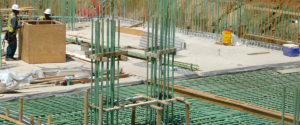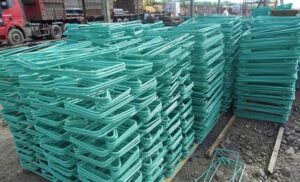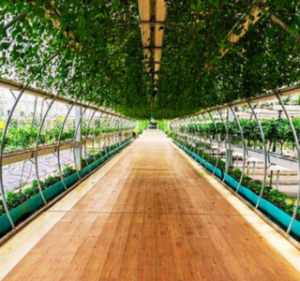When you think of construction, what comes to mind? Steel beams, concrete, brick, and mortar, right? But as we hurtle toward a future that demands sustainability, the materials we’ve relied on for centuries are being challenged. Enter Glass Fiber Reinforced Polymer (GFRP) rebar—a material that’s not just changing the game but redefining it entirely. If you care about durability, economy, and sustainability, GFRP might just be the one material that checks all the boxes, unlike any other.
Why Do We Need a New Construction Material?

Let’s start with a simple question: Why change what’s been working for decades? The answer lies in the growing realization that our traditional building materials, especially steel rebar, come with significant drawbacks. Steel has served us well, but it’s not without its flaws. The environmental challenges we face today have forced us to rethink the materials we use to build our homes, bridges, and skyscrapers.
- High Carbon Footprint: Steel rebar is incredibly energy-intensive to produce. The process involves burning fossil fuels at high temperatures, contributing significantly to global greenhouse gas emissions. If we’re serious about combating climate change, the carbon footprint of our construction materials must be addressed.
- Corrosion and Maintenance: Steel rebar is notorious for its susceptibility to corrosion. In environments exposed to moisture, chemicals, or salt (think coastal areas or de-iced roads), steel can deteriorate rapidly. This not only shortens the lifespan of the structure but also leads to increased maintenance costs and frequent repairs.
- Resource Depletion: Steel production relies heavily on finite natural resources like iron ore and coal. As these resources become scarcer, the cost and environmental impact of steel production will only increase, making it an unsustainable choice for the future.
So, what’s the alternative? Is there a material that can offer durability, economic efficiency, and sustainability all at once? Enter GFRP rebar.
GFRP Rebar: The Triple Threat—Durability, Economy, and Sustainability

GFRP rebar is not just another alternative; it’s a revolutionary material that addresses the major shortcomings of steel while offering its own set of compelling benefits. Let’s break down why GFRP rebar is a game-changer.
Durability Like No Other

Picture this: a bridge built to withstand the test of time, immune to the ravages of rust and corrosion. GFRP rebar makes this possible. Unlike steel, GFRP rebar is made from composite materials that do not corrode, even in the harshest environments. Whether submerged in seawater or exposed to chemicals, GFRP remains unaffected, ensuring the longevity of the structures it supports.
What does this mean for you?
- Longer Lifespan: Structures reinforced with GFRP rebar require far less maintenance and can last significantly longer than those using traditional steel.
- Lower Maintenance Costs: Imagine not having to worry about rust and corrosion eating away at your building or bridge. GFRP rebar’s durability translates into huge savings on repairs and upkeep.
Economic Efficiency: Saving More Than Just Money

At first glance, GFRP rebar might seem more expensive than steel. But let’s look at the bigger picture. The true cost of a building material isn’t just the price tag at purchase; it’s the cost over its entire lifecycle.
- Reduced Repair Costs: Because GFRP rebar doesn’t corrode, you won’t face the same repair costs that come with steel. This makes GFRP rebar a smart long-term investment.
- Lightweight and Easy to Handle: GFRP rebar is about one-fourth the weight of steel. This means reduced transportation costs, easier handling, and faster installation—all contributing to lower overall project costs.
- Energy Savings: Since GFRP rebar requires less energy to produce and transport, it contributes to significant energy savings throughout a project’s lifecycle.
Sustainability: Building a Greener Tomorrow

If there’s one word that defines GFRP rebar, it’s “sustainable.” In a world where the construction industry is under increasing pressure to reduce its environmental impact, GFRP rebar stands out as a material that supports sustainability without compromising on performance.
- Low Carbon Footprint: The production of GFRP rebar emits significantly fewer greenhouse gases compared to steel. This aligns perfectly with the goals of green construction and global efforts to reduce carbon emissions.
- Recyclability: Unlike some traditional materials, GFRP rebar can be recycled, making it a more environmentally responsible choice.
- Energy-Efficient Production: Producing GFRP rebar requires less energy, which reduces its environmental impact right from the start.
The Material with All Three Benefits: Is There Really No Other?
Consider this: most building materials excel in one or two areas—durability, economy, or sustainability—but rarely all three. Steel is durable and economical but falls short on sustainability. Wood is sustainable and economical but lacks durability in many applications. Concrete is durable and somewhat economical but isn’t the most sustainable option. GFRP rebar, on the other hand, is the only material that offers all three benefits, making it a truly unique solution in the construction industry.
Real-Life Applications: Where GFRP Rebar Shines

GFRP rebar isn’t just theoretical; it’s already being used in projects around the world, proving its worth in a variety of challenging environments.
- Coastal Infrastructure: In regions exposed to saltwater, such as bridges and seawalls, GFRP rebar’s corrosion resistance is invaluable. These structures are now lasting longer and require less maintenance, saving taxpayers money in the long run.
- Underground and Subterranean Projects: GFRP rebar is increasingly used in tunnels and underground structures where moisture and corrosive elements are a constant threat. Its non-conductive properties also make it ideal for areas with high electrical interference.
- Residential and Commercial Buildings: From green homes to high-rise buildings, GFRP rebar is helping builders create structures that are not only stronger but also more sustainable.
Conclusion: GFRP Rebar—The Future of Construction Is Here
The construction industry is at a crossroads. The materials we choose to build with today will determine the future we live in tomorrow. GFRP rebar offers a rare combination of durability, economic efficiency, and sustainability that no other material can match. It’s time to embrace this innovative solution and build a future that’s not only stronger but also greener and more cost-effective.
So, the next time you’re planning a construction project, ask yourself: Do I want a material that only meets some of my needs, or do I want one that delivers on all fronts? With GFRP rebar, you don’t have to compromise. It’s time to build smarter, build stronger, and build sustainably. The future of construction is here, and it’s looking bright. Are you ready to be a part of it?
